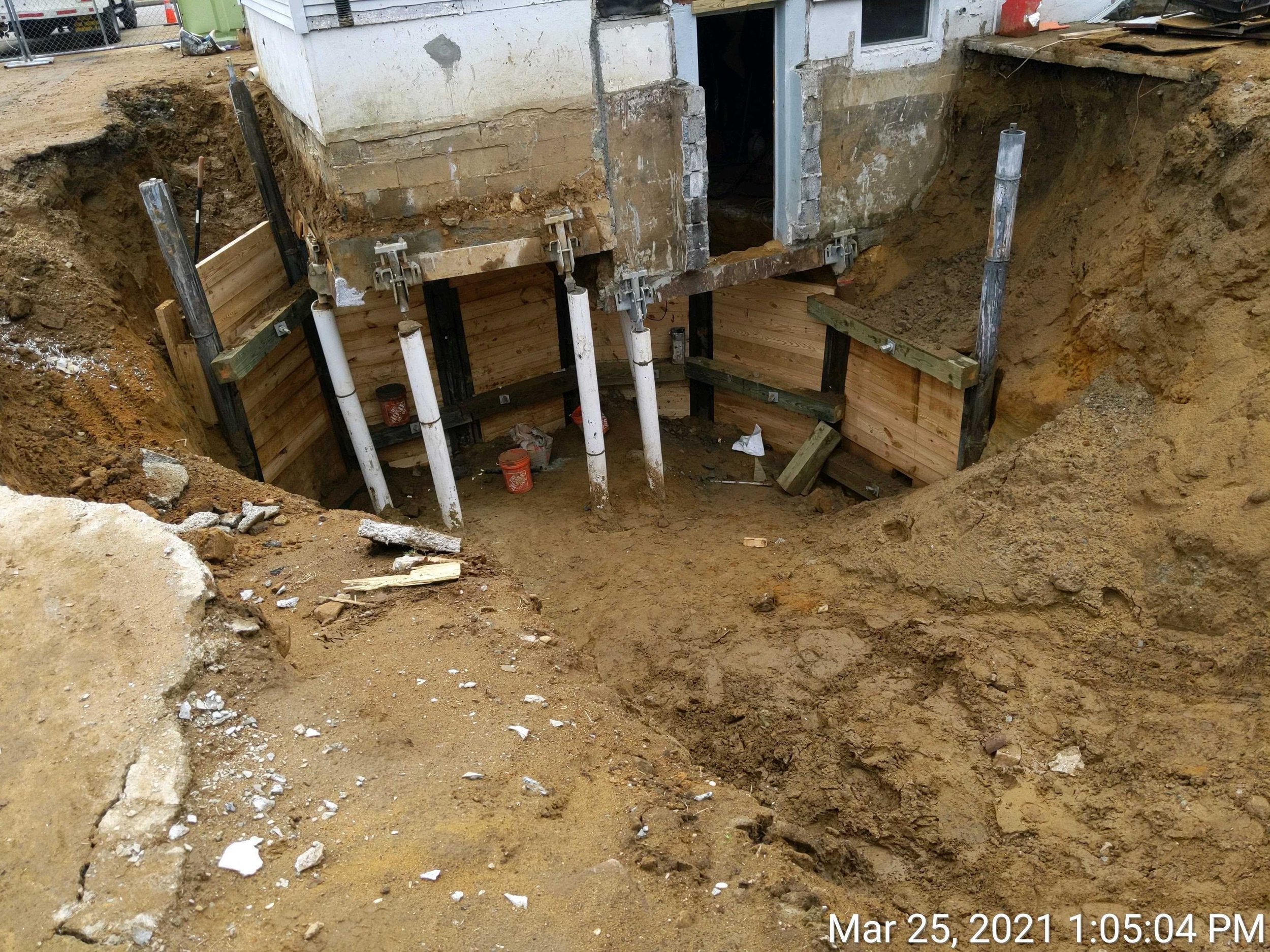Support of Excavation Using Soldier Piles
Engineers often face the challenge of how to support excavation in an efficient and cost-effective way. There are a number of options available, such as using soldier piles. Soldier piles are an effective way to support excavations and have been used for centuries. In this blog post, we will explore the use of soldier piles and discuss some of the benefits they offer. We will also look at some of the factors you should consider when deciding whether or not soldier piles are the right solution for your project.
Excavation using soldier piles can provide an economical and efficient way to support deep excavation. When properly installed, soldier piles can resist lateral loads and prevent the spread of soil settlement. In this blog post, we'll take a closer look at the benefits of soldier pile systems and how they can be used to support excavation projects. We'll also explore some installation tips to help you get the most out of your soldier pile system. So if you're curious about soldier piles, let's get started, read on!
What are soldier piles and how do they work?
Soldier piles are a common retaining wall strategy in which H-shaped steel beams (“piles”) are drilled deep into the earth at regular intervals. Usually, soldier piles are 2 to 4 yards apart. In between each vertical pile, horizontal supports fill the gap, helping to spread the load. Pile contractors often use soldier piles when the soil is too weak or unstable to support other types of retaining walls.
For example, if the soil is too sandy or has a high clay content, it might not be able to handle the weight of a traditional gravity wall. Soldier piles can also be used in areas where there is a risk of earthquake damage. The horizontal supports help to stabilize the structure and prevent it from toppling over in the event of an earthquake. When steel H beams and wood lagging are used it is typically called the “Berlin Wall Method”.
Why are they called soldier piles?
Piling companies are frequently asked about the origins of soldier piles. The “soldier” portion of the name derives from the visual appearance of a long straight line of soldiers standing at attention. Pilings, on the other hand, get their name from the medieval city where they were first used, Piling, China, now known as Changzhou. Piling was an important city in medieval China, and it was known for its advanced engineering. Piling companies are proud to continue the tradition of using this ancient technique to build modern structures.
What is a soldier pile made of?
The piles are made of steel and driven into the ground to help distribute the weight of the structure from the loose topsoil down to the rock below. This type of pile can also be used to create retaining wall systems for temporary projects, such as excavation during the construction phases. Pile contractors usually create soldier piles to be later used as part of a larger project. For example, if you are building a new home, the contractor will first excavate the area where your foundation will be built. To ensure that the sides of the excavation don't collapse, they'll install soldier piles around the perimeter of the excavation. Once the excavation is complete and they build the foundation, the soldier piles can be removed.
Are soldier piles permanent?
Soldier piles are commonly used in both temporary and permanent applications. In a temporary application, soldier piles are used to support of excavation. The soldier piles are typically left in place after the excavation is complete and the wall is constructed. In a permanent application, soldier piles are used to support the earth retention system and the wall is constructed on top of the soldier piles.
The decision to use soldier piles in a temporary or permanent application is dependent on the project requirements. For example, if the wall needs to be removed at a later date, then soldier piles would be used in a temporary application. However, if the wall is going to be left in place permanently, then soldier piles would be used in a permanent application.
How deep can soldier piles go?
Engineered soldier piles can go as deep as 15ft or more, however, most are kept to under 15ft. This is because the steel section must be increasingly stiffer to control wall displacements. Soldier piles are used when excavation depths are deep or the soils are poor. Cantilever depths are usually kept to under 15ft because controlling wall displacements requires an increasingly stiffer steel section. In most cases, the decision on how deep to go is made by the engineer.
What are lagging walls?
A lagging wall is an earth retention system used to prevent soils from moving into an excavation. Lagging walls are typically installed with wood, concrete, or shotcrete lagging. Piling contractors specialize in the installation of lagging walls. Lagging walls are used to retain soil in place and can be used for both temporary and permanent applications. When installed properly, lagging walls are a safe and effective way to prevent soil erosion or collapse.
The benefits of using soldier piles over other methods of support.
Engineered excavation support systems like soldier pile walls are used when excavating below the water table or in other difficult soil conditions. The major advantages of soldier pile walls are that they are cheaper when compared to other systems and they can be easily adjusted in the field to accommodate changes.
As compared to shoring with timber or cribbing, soldier piles transfer less horizontal forces to the wall facing. This results in lower facings costs and allows for excavations to be made closer to existing structures. Soldier piles can be used in a variety of applications including retaining walls, cofferdams, and basement excavation. When designing soldier pile walls, it is important to consider the effects of surcharge loads, groundwater conditions, and earth pressures.
When it comes to excavation support, soldier pile walls are a popular choice for many reasons. For one, they're relatively cheaper to construct when compared to other systems. Additionally, soldier pile installation is quite versatile - if changes need to be made in the field, it's easy to do so. This makes soldier pile walls a great option for many different types of construction projects. Engineered correctly, soldier piles can provide reliable and long-lasting support for any excavation.
Advantages of Soldier Piles
There are many advantages to using soldier-piling. Soldier-piling is often used for deep excavations, shoring, and slope stabilization. Soldier-pilings are also used in the construction of underground parking garages, basements, and retaining walls.
One major advantage of soldier-piling is that it is a very fast method of construction when compared to other deep foundation methods. Soldier piles can be installed quickly and easily with a small crew, which saves on both labor costs and time.
Another advantage of soldier-piling is that it is a versatile system that can be easily adjusted in the field to accommodate changes. Lagging construction can also be very quick with soldier piling. common lagging materials include timber, shotcrete, precast concrete panels, or steel plating. Permanent transportation walls usually utilize precast concrete panels while temporary soldier pile walls in the US typically utilize timber lagging.
Lastly, the construction of soldier piles and lagging walls does not require very advanced construction techniques. This makes soldier-piling an ideal choice for many projects where time and budget are constrained. If you are looking for a contractor to build a soldier pile wall, there are many reputable companies that specialize in this type of work. Do your research and choose a company like Shore Systems Group, that has the experience and a good reputation.
Disadvantages of Soldier Piles in Supporting Excavations
There are a number of excavation support systems available to excavation support contractors, each with its own advantages and disadvantages. One such system is the soldier pile and lagging system. This system is primarily used for temporary construction, as it cannot be used in high water table conditions without extensive dewatering.
In addition, poor backfilling and associated ground losses can result in significant surface settlements. Soldier pile and lagging systems are also not as stiff as other retaining systems, and because only the flange of a soldier pile is embedded beneath subgrade, it is very difficult to control basal soil movements. While this system has its disadvantages, it remains a popular choice for excavation support due to its simplicity and low cost.
Types of soils that are appropriate for soldier pile excavation.
Piling contractors are required to have a good understanding of the soil mechanics involved in soldier pile excavation. This is because the type of soil has a direct bearing on the recommended thickness of timber lagging, as well as the appropriate spacing for the piles. Most piling contractors use common laboratory procedures for testing the soil prior to starting work.
This helps to ensure that the correct thickness of lagging is used, and that the piles are spaced correctly for the specific soil type. Once the piles are in place, excavation typically proceeds in lifts of around 5 feet. In cohesive soils, such as silts or sands, with some cohesive material present, the excavation height may need to be reduced to prevent material from moving into the excavation between the soldier piles. Non-cohesive soils are generally not considered suitable for lagging installation. As lagging is installed, excavation is completed. Depending on the backfill soils, compaction may be used to fill in any void spaces located behind the lagging.
The most common laboratory procedures for soils testing are sieve analysis, Atterberg limits, and compaction tests. Sieve analysis is used to determine the particle-size distribution of a soil. The Atterberg limits are a basic measure of the nature of a fine-grained soil. These tests help to determine if the soil is appropriate for soldier piling excavation. If the piling contractor is experienced with soldier piling and has a good understanding of soil mechanics, then most excavation problems can be avoided.
How to properly install soldier piles.
Soldier piles are an effective SOE construction. The piles may be driven, vibrated, or drilled into place. Piles are typically driven or vibrated into the ground where soil profiles do not prevent driving and where vibrations can be tolerated by adjacent structures. On newer pile driving rigs, the input energy and frequency can be adjusted during pile driving to minimize vibration.
Adjacent structures can be monitored for vibration. What often inhibits pile driving is noise and vibration. Pre drilling can be done prior to driving soldier piles to achieve better horizontal and vertical alignment.. When soldier piles cannot be driven or vibrated into the ground soldier piles can be set like fence posts. This system is most commonly used in urban areas where buildings are close together and there is a potential for damage to adjacent properties from vibrations caused by driving piles.
Conclusion:
Soldier piles are a great SOE shoring, and they offer several benefits over other methods. If you’re looking for an alternative to traditional shoring methods or need to excavate in soils that are difficult or impossible to use other techniques, soldier piles may be the solution for you. Shore Systems Group has years of experience installing soldier piles and can help you get your project off the ground quickly and safely. Contact us today to learn more about how we can help with your excavation or foundation needs.




